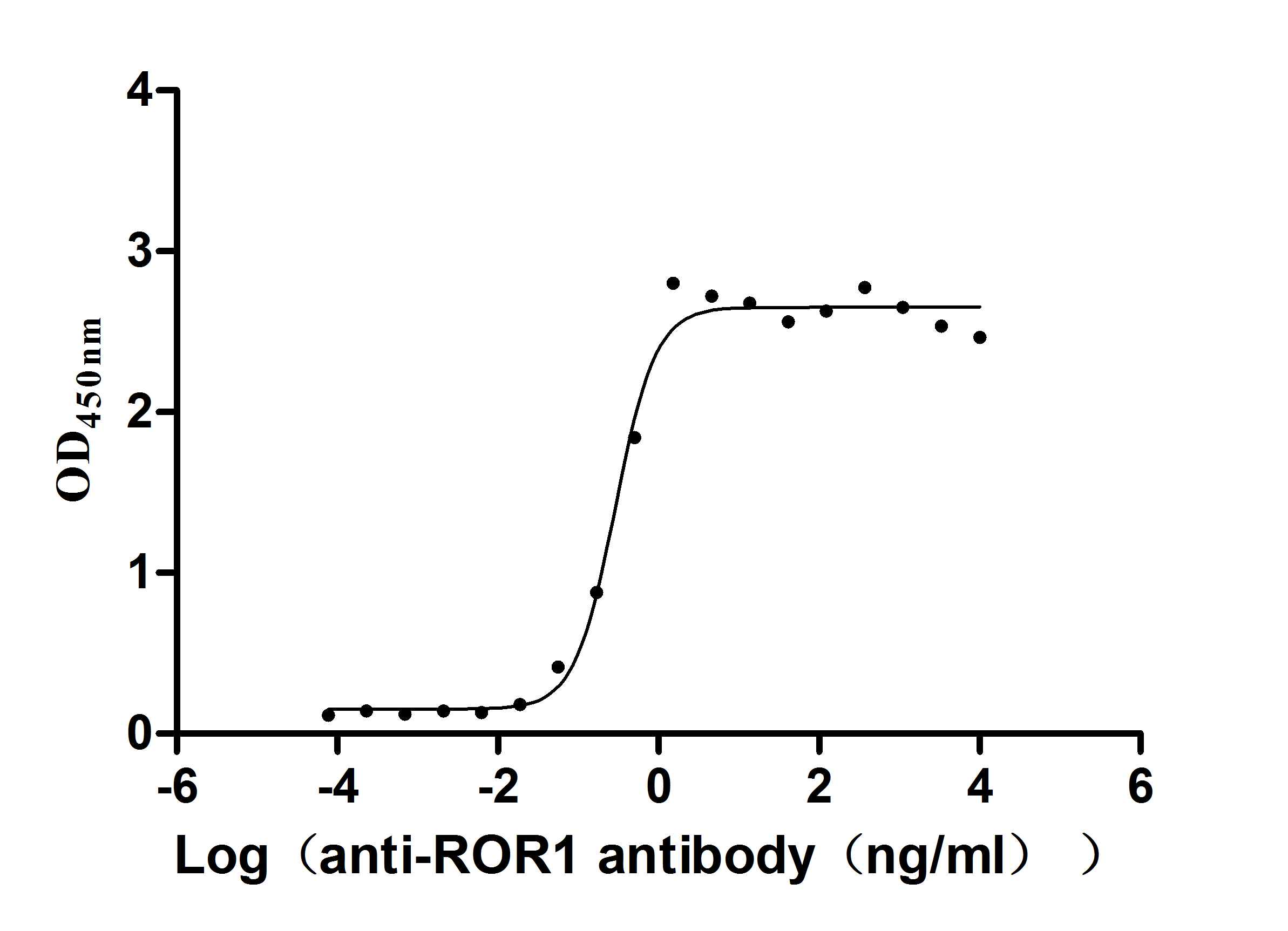Recombinant Saccharomyces cerevisiae Autophagy-related protein 3 (ATG3)
-
货号:CSB-YP334699SVG
-
规格:
-
来源:Yeast
-
其他:
-
货号:CSB-EP334699SVG
-
规格:
-
来源:E.coli
-
其他:
-
货号:CSB-EP334699SVG-B
-
规格:
-
来源:E.coli
-
共轭:Avi-tag Biotinylated
E. coli biotin ligase (BirA) is highly specific in covalently attaching biotin to the 15 amino acid AviTag peptide. This recombinant protein was biotinylated in vivo by AviTag-BirA technology, which method is BriA catalyzes amide linkage between the biotin and the specific lysine of the AviTag.
-
其他:
-
货号:CSB-BP334699SVG
-
规格:
-
来源:Baculovirus
-
其他:
-
货号:CSB-MP334699SVG
-
规格:
-
来源:Mammalian cell
-
其他:
产品详情
-
纯度:>85% (SDS-PAGE)
-
基因名:
-
Uniprot No.:
-
别名:ATG3; APG3; AUT1; YNR007C; N2040Autophagy-related protein 3; Autophagy-related E2-like conjugation enzyme ATG3
-
种属:Saccharomyces cerevisiae (strain ATCC 204508 / S288c) (Baker's yeast)
-
蛋白长度:full length protein
-
表达区域:1-310
-
氨基酸序列MIRSTLSSWR EYLTPITHKS TFLTTGQITP EEFVQAGDYL CHMFPTWKWN EESSDISYRD FLPKNKQFLI IRKVPCDKRA EQCVEVEGPD VIMKGFAEDG DEDDVLEYIG SETEHVQSTP AGGTKDSSID DIDELIQDME IKEEDENDDT EEFNAKGGLA KDMAQERYYD LYIAYSTSYR VPKMYIVGFN SNGSPLSPEQ MFEDISADYR TKTATIEKLP FYKNSVLSVS IHPCKHANVM KILLDKVRVV RQRRRKELQE EQELDGVGDW EDLQDDIDDS LRVDQYLIVF LKFITSVTPS IQHDYTMEGW
-
蛋白标签:Tag type will be determined during the manufacturing process.
The tag type will be determined during production process. If you have specified tag type, please tell us and we will develop the specified tag preferentially. -
产品提供形式:Lyophilized powder
Note: We will preferentially ship the format that we have in stock, however, if you have any special requirement for the format, please remark your requirement when placing the order, we will prepare according to your demand. -
复溶:We recommend that this vial be briefly centrifuged prior to opening to bring the contents to the bottom. Please reconstitute protein in deionized sterile water to a concentration of 0.1-1.0 mg/mL.We recommend to add 5-50% of glycerol (final concentration) and aliquot for long-term storage at -20℃/-80℃. Our default final concentration of glycerol is 50%. Customers could use it as reference.
-
储存条件:Store at -20°C/-80°C upon receipt, aliquoting is necessary for mutiple use. Avoid repeated freeze-thaw cycles.
-
保质期:The shelf life is related to many factors, storage state, buffer ingredients, storage temperature and the stability of the protein itself.
Generally, the shelf life of liquid form is 6 months at -20°C/-80°C. The shelf life of lyophilized form is 12 months at -20°C/-80°C. -
货期:Delivery time may differ from different purchasing way or location, please kindly consult your local distributors for specific delivery time.Note: All of our proteins are default shipped with normal blue ice packs, if you request to ship with dry ice, please communicate with us in advance and extra fees will be charged.
-
注意事项:Repeated freezing and thawing is not recommended. Store working aliquots at 4°C for up to one week.
-
Datasheet :Please contact us to get it.
靶点详情
-
功能:E2 conjugating enzyme required for the cytoplasm to vacuole transport (Cvt) and autophagy. Required for selective autophagic degradation of the nucleus (nucleophagy) as well as for mitophagy which contributes to regulate mitochondrial quantity and quality by eliminating the mitochondria to a basal level to fulfill cellular energy requirements and preventing excess ROS production. Responsible for the E2-like covalent binding of phosphatidylethanolamine to the C-terminal Gly of ATG8. The ATG12-ATG5 conjugate plays a role of an E3 and promotes the transfer of ATG8 from ATG3 to phosphatidylethanolamine (PE). This step is required for the membrane association of ATG8. The formation of the ATG8-phosphatidylethanolamine conjugate is essential for autophagy and for the cytoplasm to vacuole transport (Cvt). The ATG8-PE conjugate mediates tethering between adjacent membranes and stimulates membrane hemifusion, leading to expansion of the autophagosomal membrane during autophagy.
-
基因功能参考文献:
- Atg3 is localized to autophagic structures in Saccharomyces cerevisiae. PMID: 25645919
- Atg3 is an intrinsically disordered polypeptide and the disorder/order predicted for this protein from its amino acid sequence corresponds to the experimental characteristics PMID: 24879155
- Atg3 facilitates cell membrane expansion by ensuring active production of Atg8-PE on the membranes. PMID: 25680528
- Autophagic E2 enzymes Atg3 and Atg10 possess insertion regions in the middle of the core fold and may be involved in protein function. PMID: 22993095
- the crystallographic structure of Atg3 provides a molecular basis for understanding the unique lipidation reaction that Atg3 carries out PMID: 17227760
显示更多
收起更多
-
亚细胞定位:Cytoplasm.
-
蛋白家族:ATG3 family
-
数据库链接:
KEGG: sce:YNR007C
STRING: 4932.YNR007C
Most popular with customers
-
Express system: Mammalian cell
Species: Homo sapiens (Human)
-
Recombinant Mouse Prolactin receptor (Prlr), partial (Active)
Express system: Mammalian cell
Species: Mus musculus (Mouse)
-
Recombinant Human C-X-C chemokine receptor type 4 (CXCR4)-VLPs (Active)
Express system: Mammalian cell
Species: Homo sapiens (Human)
-
Recombinant Human Somatostatin receptor type 2 (SSTR2)-VLPs (Active)
Express system: Mammalian cell
Species: Homo sapiens (Human)
-
Recombinant Human Tumor-associated calcium signal transducer 2 (TACSTD2), partial (Active)
Express system: Mammalian cell
Species: Homo sapiens (Human)
-
Recombinant Mouse Cell adhesion molecule 1 (Cadm1), partial (Active)
Express system: Mammalian cell
Species: Mus musculus (Mouse)
-
Recombinant Human Cadherin-17 (CDH17), partial (Active)
Express system: Mammalian cell
Species: Homo sapiens (Human)
-
Recombinant Human Interleukin-2 (IL2) (Active)
Express system: Mammalian cell
Species: Homo sapiens (Human)




-AC1.jpg)















